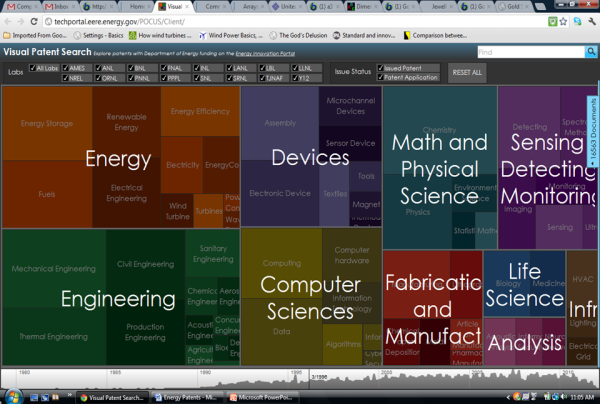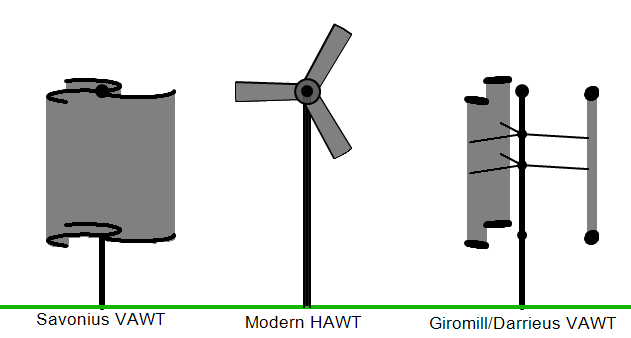Energy Patents
Through DOE Funded Research
Dr. Rajendra Prasad25 May 2012
Introduction
More than twenty six years after Chernobyl and with last year's nuclear meltdown of Fukushima
following an earthquake and tsunami, the world seems to have taken a resolve to move away from the nuclear energy.
The answer to this is definitely in developing new alternative energy technologies, the major burden of which falls
squarely on the Governments of the day since private sector investment is committed only after these technologies enter
into the realm of commercial viability. Clearly many Governments have been consistently investing in research and development
in high efficiency and alternate energy technologies for last several decades and many have even announced ambitious programmes
of changing their portfolio of energy mix by commercializing new alternative technologies in a big way in near future.
Energy Patents Originating from US Government Funded Research
With such heightened investments in research and innovation in alternate and new energy technologies,
albeit largely with Government funding, patent literature continues to grow on these technologies and one could be
tempted to search the granted patents and new patent applications in this area. The energy related patents emanating
from the projects funded by the Department of Energy, Government of USA during the last two decades are reported to
have reportedly grown to a number exceeding 16,000 and this represents an important subset of the overall energy and
energy related patents.
Searching Energy Patents
Ordinarily, patent searches are performed most readily using keyword searches which, however, seldom meet the objective of finding the right and genuine set of patents. While too broad a search terms tends to return an unmanageable number of results with a high level of noise, a narrow search term yields too few results. Getting patent search using keywords just right requires that the searcher needs to have extensive patent search experience as well as great deal of familiarity with the subject. In most cases, with a wide variety of subject areas, the alternate and preferred mode of patent search tends to be using classification codes. However, with energy related patents, this mode also presents some degree of a difficulty since these technologies are generally spread across a range of subject areas and one would need to struggle quite a bit before relevant patents are fetched.
We have previously authored two articles for searching relevant patents in the related field on our website for the benefit of our readers. These are:
Energy Innovation Portal
In this issue, we turn our attention to an Energy Innovation Portal of the Department of Energy (DOE) of the USA that provides an interesting, rich and consolidated source of US energy patents. Nonetheless, this database is exclusively that of the granted patents and the patent applications those that have resulted from the DOE-funded projects since 1992. The site provides a channel with a 'Visual Patent Search' tool which seemingly is a very valuable and interesting tool. As depicted on the site, there are sixteen US research and development institutions that have been the recipient of DOE funding during past decades and have been regularly contributing to generation of relevant technologies in energy and related areas the details of which are accessible in variety of different ways through this tool. Altogether, there are more than 16,000 documents covering issued patents as well as published patent applications accessible on this site in energy as well as energy related areas.
Classification and Graphic Visualization of documents
All documents available on the site are divided into following broad groupings, the figures in parentheses indicating the total number of patents in each of these.
- Energy (4790)
- Engineering (5545)
- Devices (3006)
- Computer Sciences (2714)
- Math and Physical Sciences (5135)
- Fabrication and Manufacturing (1330)
- Sensing, Detecting & Monitoring (2080)
- Life Science (586)
- Analysis (249)
Each of these groupings is further broken down in sub-groupings successively to narrowly defined areas that
a searcher may be directly interested in. While, it is possible to search a patent in this database through
a keyword search, searching through graphic visualization of the above groupings and their sub-groupings offers
an interesting and extremely facile mode.
As maintained by the owners of the portal, the purpose is more than simple search of available patent data.
Department of Energy's overall objective is to make the available patent data more accessible to the public,
entrepreneurs, investors and other technology seekers. Each topic is tiered, so users can drill down to very
specific fields. The site also provides information on licensing and commercialization opportunities including
venture capital funding and marketable summaries of available technologies and patents with an ultimate goal to
increase the rate and scale of energy efficiency and renewable energy technology market penetration. The site
also provides information on webinars organized from time to time on key themes.
The graphic visualization of tiered categories in the form of distinct coloured boxes on the screen is stated
to have been created with in-house software, IN-SPIRE™ originally developed by Energy Department's Pacific
Northwest National Laboratory. The software identifies word occurrence patterns across all patent records,
and creates "clusters" of results - represented as coloured boxes of groupings and sub-groupings of technology
areas, the size of each box being proportional to the word occurrence. This cool feature of patent search is
evident from the screen print of the top-tier technology area groupings as shown below. Clicking on either of
these major groupings leads one to next screen sub-groupings of the narrow technology areas as well as patent-listings
in those areas with relevant summaries. Available links within also lead to full patent details as available on USPTO site.

Conclusion
Despite obvious limitations, the Energy Innovation Portal provides an important and
interesting subset of energy and energy related patents, which any serious searcher can not overlook.
Further, the portal also provides an interesting example of how a public funded research agency may keep
the general public informed of relevant technologies being developed by tax-payers' money. It is certainly
commendable to see how the DOE through this portal tries to develop and promote an alternative energy
ecosystem which other similar agencies in other countries may emulate.
Link to:
